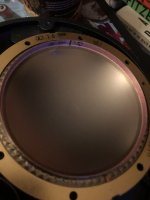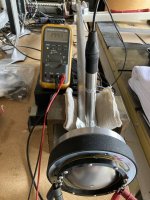Hi All,
Had a bit of a disaster recently, hoping for some advice. I've recently built a copy of a Yuichi A290 and had it fitted with the JBL 2446H. It was working well and was sounding really good until one of the channels of my amps gave up out of the blue. This channel was powering the JBL and as the amp was significantly overpowered for the speaker I jumped to the conclusion that I'd blown the driver and took it apart to examine the voice coil / diaphragm.
It's only after significant further testing that I realised it was the channel on my amp (although no idea why that's blown...). I've put the JBL back together but the sound has significantly degraded and there's quite severe crackling. Does anybody have any idea what I could have done to the driver? I'm using a test tone to re-install the diaphragm and making sure of a pure tone whilst I do so, but the sound still lacks when i play music through it, especially at higher volumes.
Any help would be really appreciated, have unfortunately had to cancel plans to use my system for NYE... Terrible timing.
Had a bit of a disaster recently, hoping for some advice. I've recently built a copy of a Yuichi A290 and had it fitted with the JBL 2446H. It was working well and was sounding really good until one of the channels of my amps gave up out of the blue. This channel was powering the JBL and as the amp was significantly overpowered for the speaker I jumped to the conclusion that I'd blown the driver and took it apart to examine the voice coil / diaphragm.
It's only after significant further testing that I realised it was the channel on my amp (although no idea why that's blown...). I've put the JBL back together but the sound has significantly degraded and there's quite severe crackling. Does anybody have any idea what I could have done to the driver? I'm using a test tone to re-install the diaphragm and making sure of a pure tone whilst I do so, but the sound still lacks when i play music through it, especially at higher volumes.
Any help would be really appreciated, have unfortunately had to cancel plans to use my system for NYE... Terrible timing.
If you are clacking are you sure you have your high pass filter in place??? Other than that takes allot to damage a Ti surround. Could be a voice coil form separation. Don't know for sure.
Rob 🙂
Rob 🙂
Thanks for the response Rob, high pass filter is in place. How's best to check for voice coil seperation? would that be as simple as the coil coming away from diaphragm? when I took the diaphragm off it all seemed to be fine in there but perhaps I don't quite know what I'm looking for - very new to owning this type of equipment!
cheers,
Lawrence
cheers,
Lawrence
You measured the resistance of both drivers?Thanks for the response Rob, high pass filter is in place. How's best to check for voice coil seperation? would that be as simple as the coil coming away from diaphragm? when I took the diaphragm off it all seemed to be fine in there but perhaps I don't quite know what I'm looking for - very new to owning this type of equipment!
Can you do a impedance sweep of both drivers on the same horn?
Any diaphragm related issue will show there.
go to 12.50 in this video linked below, if that is the kind of crackling you describe, you will also know the cause.
It is also possible there is some crud in the gap, unless you cleaned it out before reassembly?
Crackling sounds can also come from a bad amp channel.
Thanks for all the suggestions here. I only have one so far (still trying to source a second driver) but resistance across it is 4.5 ohms so think that's about normal? Don't think there's any stuff lodged in the gap, just reassembled and double checked. The amp channel also seems ok into other drivers.
I'll try and get the bits required to do a proper impedance sweep.
I get a fairly clean tone but I think I need to try refitting with a higher test tone as it’s frequencies <5k that seem to be where the issue occurs.
I'll try and get the bits required to do a proper impedance sweep.
I get a fairly clean tone but I think I need to try refitting with a higher test tone as it’s frequencies <5k that seem to be where the issue occurs.
DC resistance should be 4.3 ohms, which would be less if coils shorted together, 4.5 ohms sounds ballpark normal.Thanks for all the suggestions here. I only have one so far (still trying to source a second driver) but resistance across it is 4.5 ohms so think that's about normal? Don't think there's any stuff lodged in the gap, just reassembled and double checked.
The diaphragm looks clean, doesn't show signs of hammering the phase plug, or the former separating.
The "slight damage to the diaphragm" may have been from a loose bit of junk (bit of phase plug, adhesive, etc.) can't really tell from the photo angle.
"Quite severe crackling" might be a sign of misalignment.
Alignment pins or rings on the JBL diaphragms generally will center the diaphragm adequately to prevent rubbing and buzzing, but they do not guarantee it.
A narrow frequency band, sometimes only a few Hz wide, may trigger a “buzz” distortion. For that reason, misalignment distortion may not be at all evident except with certain musical passages, making music, pink noise, or even specifically spaced sine wave tones near useless for alignment.
In most cases, low frequencies of several octaves below the usual pass band will make the harmonic distortion most audible. After determining a reasonable mid pass band output level, slowly sweep from 200 Hz up, listening for "buzz". Most times the range between 200 Hz to 800 Hz will reveal the "buzzing", but I have found a few diaphragms that only buzzed when driven at anywhere from 800 Hz to 5kHz or so.
The horn, or even the long throats of "old school" drivers like your 2446 makes the diaphragm output much louder, which will mask a dragging voice coil distortion component. Removing the driver from the horn, or stuffing the horn with rags, or laying it mouth down on a rug or carpet makes the buzz easier to hear.
Next, remove the diaphragm, fully clean the magnetic gap with masking tape, (it can take many runs around both directions before the tape comes out clean) check that the gap is symmetrical with a depth gauge which can be made from paper card stock, if not symmetrical it must be made so. You can't fix that problem without demagnatizing and remagnatizing..
To align the diaphragm, re-install the diaphragm with it's screws just loose enough to not rattle, but tight enough to allow one to tap a portion of the screw ring in the direction that eliminates the buzz, then re-sweep to determine this did not cause a buzz at a different frequency, then tighten the screws fully, and test again. Lather, rinse, repeat ;^).
Even with many modern diaphragms supposedly "self aligning", they often ain't.
Art
Thanks for the very detailed response Art, appreciate the time that you and others here have taken to give me advice.
I think you guys have confirmed that it’s likely an alignment issue then as it was working well until I took it apart.
Sounds fiddly to correct but the clear set of instructions here give me some hope that I can get it running smoothly again.
Many thanks
Lawrence
I think you guys have confirmed that it’s likely an alignment issue then as it was working well until I took it apart.
Sounds fiddly to correct but the clear set of instructions here give me some hope that I can get it running smoothly again.
Many thanks
Lawrence
In that video the 2450SL is incorrectly assembled and while the person showed some pretty amazing repair skills, that driver was reassembled incorrectly.
Looking through my pics this is the only one I can find that clearly shows one of two coil lead reliefs machined in the magnetic gap.
With the JBL label at 6 o’clock, the reliefs will be at 3 and 9. They are not quite symmetrical. The colored lead, red or green will be on he left, at 9 o'clock.
The eight diaphragm mounting bolts are symmetrical so you can miss and then it is difficult to impossible to get the coil not to rub.
Hopefully this helps.
Barry.
Here is a better picture. This is oriented so the JBL label is at 12 o'clock. Looking carefully you can see where the magnetic gap widens just a bit
Likely you have a rub, unless you have a damaged voice coil or debris in the gap. You can clean the gap with card stock. I have not worked on the 2446 but have long owned an older pair of 2440 and a number of other drivers, despite the presence of guide pins it is still possible to have a rub. (So much for the self aligning claim.) I've found installing the diaphragm loosely and connecting a signal generator to the driver that it is often possible to minimize distortion by very carefully tightening the mounting screws. Tighten opposing screws one at a time and keep working around tightening and adjusting until buzz is minimized. There should no crackle. Good luck.
Make sure wires are not touching the diaphragm and are fully tightened on the diaphragm terminals.
Replacement options include Radian and Tru-Extent if it proves necessary. As memory serves these are titanium diaphragms, the 2445 'phragms were the least favorite of the ones I have owned.
Welcome to A-290 land, the exit angle of the 2446 should be compatible with your horn. I have a pair of A-290 clones with TAD TD-4001. I will characterize the performance as interesting. (after far too much work)
Make sure wires are not touching the diaphragm and are fully tightened on the diaphragm terminals.
Replacement options include Radian and Tru-Extent if it proves necessary. As memory serves these are titanium diaphragms, the 2445 'phragms were the least favorite of the ones I have owned.
Welcome to A-290 land, the exit angle of the 2446 should be compatible with your horn. I have a pair of A-290 clones with TAD TD-4001. I will characterize the performance as interesting. (after far too much work)
Hello Rob;Isn't the dot at 3 o'clock, the outer ring, the positive terminal alignment mark??
Rob 🙂
It sure is. These are odd ball drivers. 2450CM is the model. They were made for the Compact Monitor Systems and are 2482Nd’s.
In this pic they are “upside down” compared to the others where the label is at the 12 O’clock position.
I am just going through my old pics so these aren’t the best for illustration but here is a regular old 2451 with the label at 6 O’clock and the dimple is also on the right at 3 O’clock.
I always polarity check on the old PWT.
Attachments
Thank you all! will let you know how i get on with fixing this once i get some time to have a play around with it again!
- Home
- Loudspeakers
- Multi-Way
- JBL 2446 diaphragm assistance

